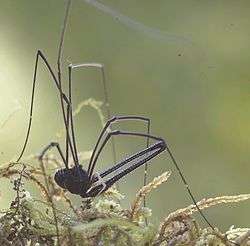Neopilionidae
It has a clearly Gondwanan distribution, with species found in Australia, South Africa and South America, and probably represent relicts of that time.
| Neopilionidae | |
|---|---|
 | |
| Pantopsalis listeri | |
| Scientific classification | |
| Kingdom: | |
| Phylum: | |
| Class: | |
| Order: | |
| Suborder: | |
| Superfamily: | |
| Family: | Neopilionidae Lawrence, 1931 |
| Diversity | |
| 8 genera, 15 species | |
The Neopilionidae are a family of harvestmen.
The family members range in size from the small Americovibone lancafrancoae (0.9 mm) to over 4 mm in the Enantiobuninae.[1]
Some species of Enantiobuninae have blue pigmentation, which is rather unusual in harvestmen.[1]
Name
The family name is a contraction of Ancient Greek neo "new" and Latin Opilio, a genus of harvestman.
Species
- Neopilioninae Lawrence, 1931
- Neopilio Lawrence, 1931
- Neopilio australis Lawrence, 1931 — South Africa
- Ballarrinae Hunt & Cokendolpher, 1991
- Americovibone Hunt & Cokendolpher, 1991
- Americovibone lanfrancoae Hunt & Cokendolpher, 1991 — Chile
- Arrallaba Hunt & Cokendolpher, 1991
- Arrallaba spheniscus Hunt & Cokendolpher, 1991 — Australia
- Ballarra Hunt & Cokendolpher, 1991 — Australia
- Ballarra alpina Hunt & Cokendolpher, 1991 — New South Wales
- Ballarra cantrelli Hunt & Cokendolpher, 1991 — Queensland
- Ballarra clancyi Hunt & Cokendolpher, 1991 — New South Wales
- Ballarra drosera Hunt & Cokendolpher, 1991 — New South Wales
- Ballarra longipalpus Hunt & Cokendolpher, 1991 — Western Australia
- Ballarra molaris Hunt & Cokendolpher, 1991 — Victoria
-
- Plesioballarra Hunt & Cokendolpher, 1991
- Plesioballarra crinis Hunt & Cokendolpher, 1991 — Queensland
- Vibone Kauri, 1961
- Vibone vetusta Kauri, 1961
- Enantiobuninae Mello-Leitão, 1931
- Thrasychiroides Soares & Soares, 1947
- Thrasychiroides brasilicus Soares & Soares, 1947 — Brazil
- Thrasychirus Simon, 1884
- Thrasychirus dentichelis Simon, 1884 — Chile, Argentina
- Thrasychirus gulosus Simon, 1884 — Chile, Argentina
- Thrasychirus modestus Simon, 1902 — Chile, Argentina
Footnotes
- Cokendolpher, James C. (2007): Neopilionidae Lawrence, 1931. In: Pinto-da-Rocha et al. 2007: 121ff
gollark: They will... not work!
gollark: So it suspends most programs properly, at least.
gollark: Yes, and I bodged `sleep` to work with that.
gollark: And is standalon.
gollark: This one is *slightly* fancy, in that it allows suspending processes.
References
- Joel Hallan's Biology Catalog: Neopilionidae
- Pinto-da-Rocha, R., Machado, G. & Giribet, G. (eds.) (2007): Harvestmen - The Biology of Opiliones. Harvard University Press ISBN 0-674-02343-9
This article is issued from Wikipedia. The text is licensed under Creative Commons - Attribution - Sharealike. Additional terms may apply for the media files.